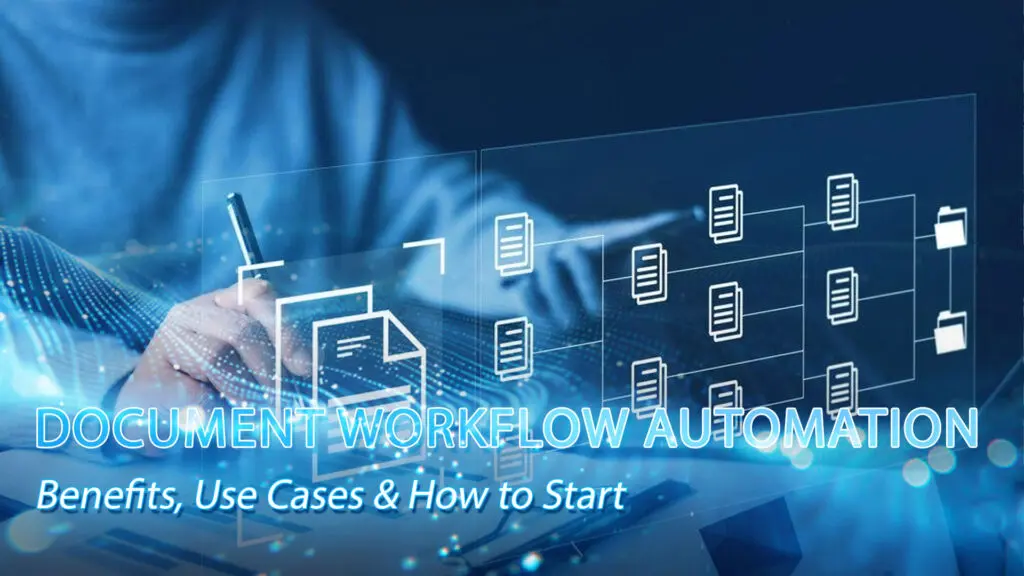Understanding automate document workflow is key to effective business operations. Efficient document management safeguards organizational best practices, key decisions, and historical experiences. Ensuring that this knowledge is accessible to current and future employees helps reduce excessive time spent searching for documents and silos duplicate efforts. DIGI-TEXX aims to prepare all business practitioners on document automation workflows by explaining what it is, the associated benefits, important trends, and steps to manage documents effectively.
=> You might like: Choosing the Right Document Processing Companies for Your Needs

What Is Document Workflow Automation?
As the name suggests, automate document workflow refers to an automated technology-based system that tracks and manages documents throughout their life cycles. In this case, document management and workflow automation refer to the configuration of task assignment in the software that documents set rules to be performed automatically. An example would be cleaning the way a dishwasher does after loading it with dirty plates.
With automation in place, invoices, contracts, and onboarding files are processed on a predetermined course from beginning to end. This minimizes the manual work to be done, increases speed, and eliminates errors and delays.
=> See more: Understanding Automated Document Processing: Benefits & Use Cases

Document workflow automation refers to an automated technology-based system
Advantages of Document Workflow Automation
The best automated document workflows yield significant benefits for busy accountancy and CPA firms. Here are some advantages of document workflow automation that you should know:
- Time Saving: Staff in accountancy firms and CPAs can now focus on more important work as routine tasks such as approvals and tracking are automated. Tasks that would take days can now take mere minutes.
- Reducing Errors: Automation ensures compliance and greater accuracy by eliminating mistakes such as wrong data entries or missing files.
- Collaboration: All team members can modify and access documents without the need to send back and forth emails, making it easier for teams to work together.
- Compliant: Automated systems fulfill compliance requirements by tracking changes, managing retention, and securing sensitive data.
- Improving Access: Documents can now be retrieved and searched due to the organized storage, which eliminates the need to sift through endless folders.
- Shifting the Focus: Every action that every staff member takes is tracked, which makes it easier to monitor progress and fix issues, leading to greater accountability.

Advantages of Document Workflow Automation
Key Trends in Document Management and Workflow Automation
The major features of document management and automation workflow are:
Automation of Document Workflow Using AI
Image, PDF, and file data can now be extracted using OCR, AI, and deep learning tools. Fields can be auto-filled without the need for manual input.

Image, PDF, and file data can now be extracted
Integration with ERP and CRM Systems
Time wasted while switching between tools is now reduced as modern systems easily connect with Salesforce and SAP.
Cloud-Based Storage and Collaborative Solutions
Employees can now work in support of hybrid and remote work because they can access cloud storage in real time from any location, which enables teamwork.

Employees can now work in support of hybrid and remote work
Improved Security Measures
Features like multi-factor authentication, encryption, and audit trails help protect data and ensure compliance.
Sustainable and Eco-Friendly Workflows
Paperless workflows lower costs and support sustainability by reducing the need for physical documents.
How to Automate a Document Workflow?
Document automation (AD) is a series of steps that streamline workflows, helping to minimize manual intervention. Each stage plays a vital role in ensuring that ADP is efficient, effective, and aligned with business needs. Follow these 6 steps to successfully automate your AD workflow.
Step 1: Prepare
Assess your current document workflows, identify areas that need automation. Collect all relevant documents, workflows, and understand the tasks that can be automated. This step helps outline your goals, resources, and any specific needs that the automation solution needs to address.
Step 2: Automate
Implement the automation software or tools that fit your business needs, and configure the system to automatically extract, classify, and process documents. Establish rules and workflows to ensure that the automation system handles tasks such as: Extracting, storing, and retrieving data and eliminating the need for manual intervention.
Step 3: Testing
To ensure the automation system is working as intended, test it using sample documents. Monitor for any errors or inconsistencies in data extraction. This step helps pinpoint areas for improvement and ensures the system can handle real-life scenarios effectively.
Step 4: Review, Evaluate
After testing, review the system’s performance with key stakeholders. Gather feedback from users and make necessary adjustments. Confirm that the system aligns with business objectives, and workflows, and complies with all relevant regulations to avoid any future complications.
Step 5: Rollout
Once the system has been reviewed and adjusted, it is time to roll it out across your entire organization. Train employees to understand how to interact with the system. Roll out the automation solution gradually, ensuring all users are comfortable and the system is running smoothly in real-time.
Step 6: Evaluate
After the automation system has been rolled out, continually evaluate its performance. Track key metrics such as processing speed, accuracy, and user satisfaction. Regularly evaluate the system’s impact on efficiency and identify opportunities for further improvement or optimization to ensure continued success and alignment with business goals.
If you know how to automate document workflow effectively, you can enhance efficiency by optimizing tasks and workflows, including document management. As a result, many transactions can be completed in under two hours, boosting overall productivity. Explore DIGI-TEXX’s innovative offerings for advanced automation document solutions to transform your business workflow.
=> Read more:


